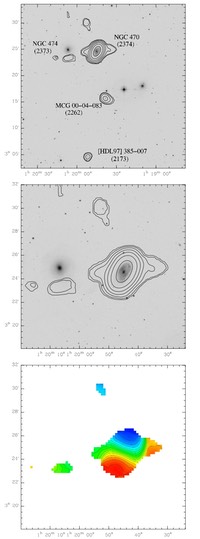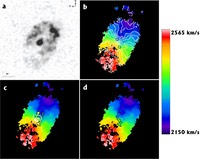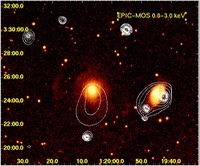Arp 227 is pair composed of a barred spiral, NGC 470, and a lenticular, NGC 474, showing a spectacular shell system. Several authors have debated about the shells origin in NGC 474 although they are generally considered to be generated through an (or more recently multiple) accretion event(s) that have also generated a stellar counter-rotation in its nucleus. The study of the pair could then offer both a snapshot of ETGs secular evolution in LDE and probably also a valuable insight about poor groups evolution.
We have investigated the hot, warm and cold gas properties in Arp 227 using XMM-Newton, the GHASP Fabry-Perot instrument, archival HI VLA observations and BIMA CO(J=1-0) observations.
The most evident signature of interaction lies in the HI distribution which shows a gas tail connecting the spiral member to NGC 474. The HI disk appears warped.Our measure of the value of MH2/MHI+H2 is 0.27 suggesting that the encounter is in a very early-stage according to models of gas evolution during galaxy-galaxy encounters. During the first phase of an encounter, these models predict a strong gas infall toward the galaxy centre.
Another evidence of the on-going interaction is the detection of a secondary components in the Ha emission in the centre of NGC 470. This component is clearly separated from the main one mapping a nearly-unperturbed velocity field. The filamentary shape and the velocities of these patches of ionized gas superimposed onto the central parts of the disk of NGC470 suggests that these clouds mark a probable gas infall. The main, nearly-unperturbed trend of the kinematics is confirmed by CO observations, although restricted to the centre of NGC470. The NGC 470 mass model shows that in the inner 20 kpc the disk component is dominant.
The X-ray luminosity of NGC 470 is comparable with that of a normal spiral galaxy. The X-ray luminosity of NGC 474 is consistent with emission from discrete sources: it is about two orders of magnitude lower than that of early-type galaxies at the centre of X-ray luminous poor groups. There is no evidence of emission from a group potential. This could be an additional evidence that the pair is at an early stage of its evolution and the build-up of the IGM is just begun.
Both the large NGC 474 shell system, probably produced by multiple accretions (see Sikkema et al. 2007), and the gas rich, faint late-type companions detected in HI south of NGC 470 suggest that Arp 227 could be a possible poor group and could then represent the evolution in low density environments. Indeed both the MH2/MHI+H2 and LX/LB ratios for NGC 470 are indistinguishable from those of isolated galaxies. If it is a bound system, Arp 227 is a snapshot of a group in the early phases of its evolution whose drivers are the accretion of faint companions and the ongoing large scale interaction between the dominant members NGC 470 and NGC 474.
more details in
Rampazzo R., Alexander P., Carignan C., Clemens M.S., Cullen H., Garrido O., Marcelin M., Sheth K., Trinchieri G.
The hot, warm and cold gas in Arp 227 - an evolving group
2006, MNRAS, 368, 851


